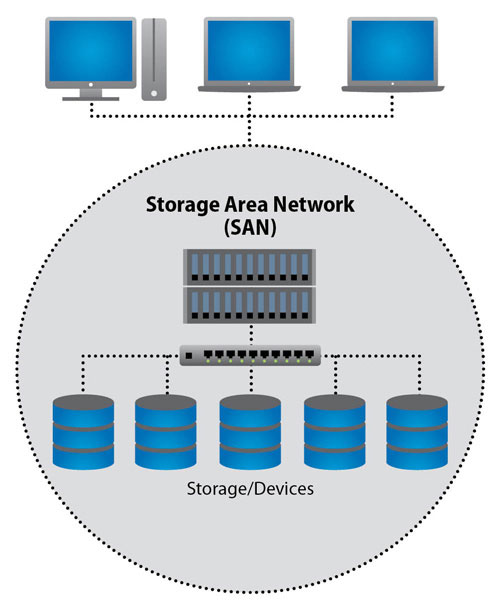What is SAN?
Storage area networks (SANs) are the most common storage networking architecture used by enterprises for business-critical applications that need to deliver high throughput and low latency. A rapidly growing portion of SAN deployments leverages all-flash storage to gain its high performance, consistent low latency, and lower total cost when compared to spinning disk. By storing data in centralized shared storage, SANs enable organizations to apply consistent methodologies and tools for security, data protection, and disaster recovery
A SAN is block-based storage, leveraging a high-speed architecture that connects servers to their logical disk units (LUNs). A LUN is a range of blocks provisioned from a pool of shared storage and presented to the server as a logical disk. The server partitions and formats those blocks—typically with a file system—so that it can store data on the LUN just as it would on local disk storage
SANs make up about two-thirds of the total networked storage market. They are designed to remove single points of failure, making SANs highly available and resilient. A well-designed SAN can easily withstand multiple component or device failures.


SAN Use Cases
Storage area networks are frequently deployed in support of business-critical, performance-sensitive applications such as:
Oracle databases. These are frequently business-critical and require the highest performance and availability.
Microsoft SQL Server databases. Like Oracle databases, MS SQL Server databases commonly store an enterprise’s most valuable data, so they require the highest performance and availability.
Large virtualization deployments using VMware, KVM, or Microsoft Hyper-V. These environments often extend to thousands of virtual machines running a broad range of operating systems and applications, with different performance requirements. Virtualized environments concentrate many applications, so infrastructure reliability becomes even more important because a failure can cause multiple application outages.
Large virtual desktop infrastructures (VDIs). These environments serve virtual desktops to large numbers of an organization’s users. Some VDI environments can easily number in the tens of thousands of virtual desktops. By centralizing the virtual desktops, organizations can more easily manage data protection and data security.
SAP or other large ERP or CRM environments. SAN architectures are ideal for enterprise resource planning and customer resource management workloads.
Types of SAN
The most common SAN protocols are:
Fibre Channel Protocol (FCP). The most widely used SAN or block protocol, deployed in 70% to 80% of the total SAN market. FCP uses Fibre Channel transport protocols with embedded SCSI commands.
Internet Small Computer System Interface (iSCSI). The next largest SAN or block protocol, with approximately 10% to 15% of the market. iSCSI encapsulates SCSI commands inside an Ethernet frame and then uses an IP Ethernet network for transport.
Fibre Channel over Ethernet (FCoE). FCoE is less than 5% of the SAN market place. It is similar to iSCSI, since it encapsulates an FC frame inside an Ethernet datagram. Then like iSCSI, it uses an IP Ethernet network for transport
Non-Volatile Memory Express over Fibre Channel (FC-NVMe). NVMe is an interface protocol for accessing flash storage via a PCI Express (PCIe) bus. Unlike traditional all-flash architectures, which are limited to a single, serial command queue, NVMe supports tens of thousands of parallel queues, each with the ability to support tens of thousands of concurrent commands.

SAN vs. NAS
Both SAN and network-attached storage (NAS) are methods of managing storage centrally and sharing that storage with multiple hosts (servers). However, NAS is Ethernet-based, while SAN can use Ethernet and Fibre Channel. In addition, while SAN focuses on high performance and low latency, NAS focuses on ease of use, manageability, scalability, and lower total cost of ownership (TCO). Unlike SAN, NAS storage controllers partition the storage and then own the file system. Effectively this makes a NAS server look like a Windows or UNIX/Linux server to the server consuming the storage.


SAN Protocols:
- Fibre Channel Protocol (FCP)
- Internet Small Computer System Interface (iSCSI)
- Fibre Channel over Ethernet (FCoE)
- Non-Volatile Memory Express over Fibre Channel (FC-NVMe)
